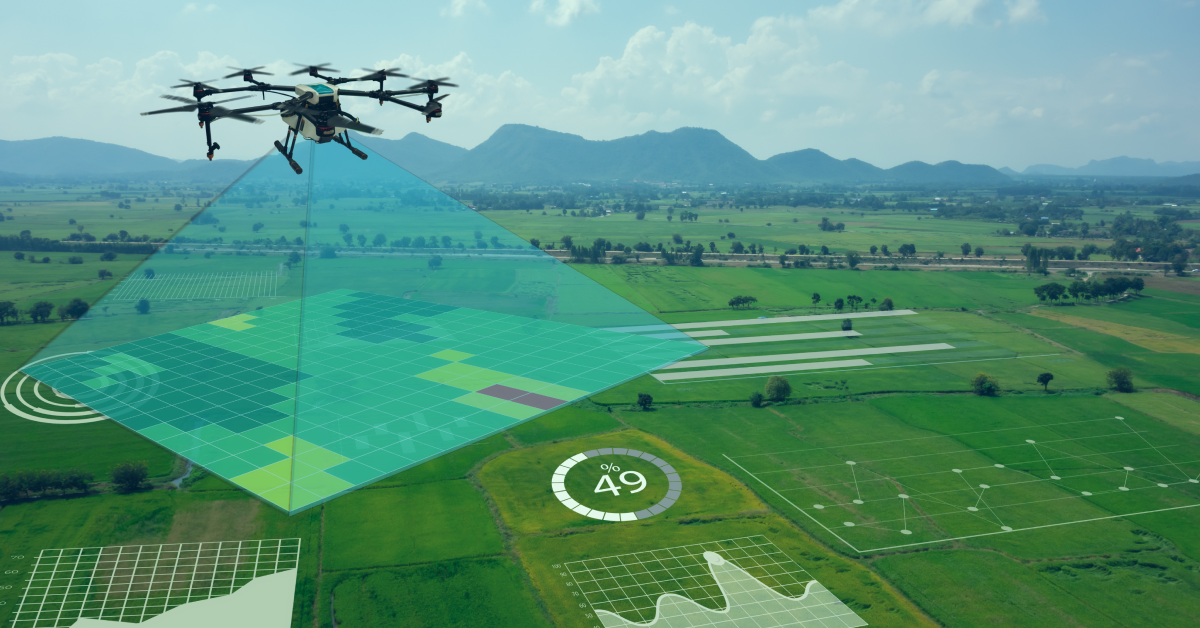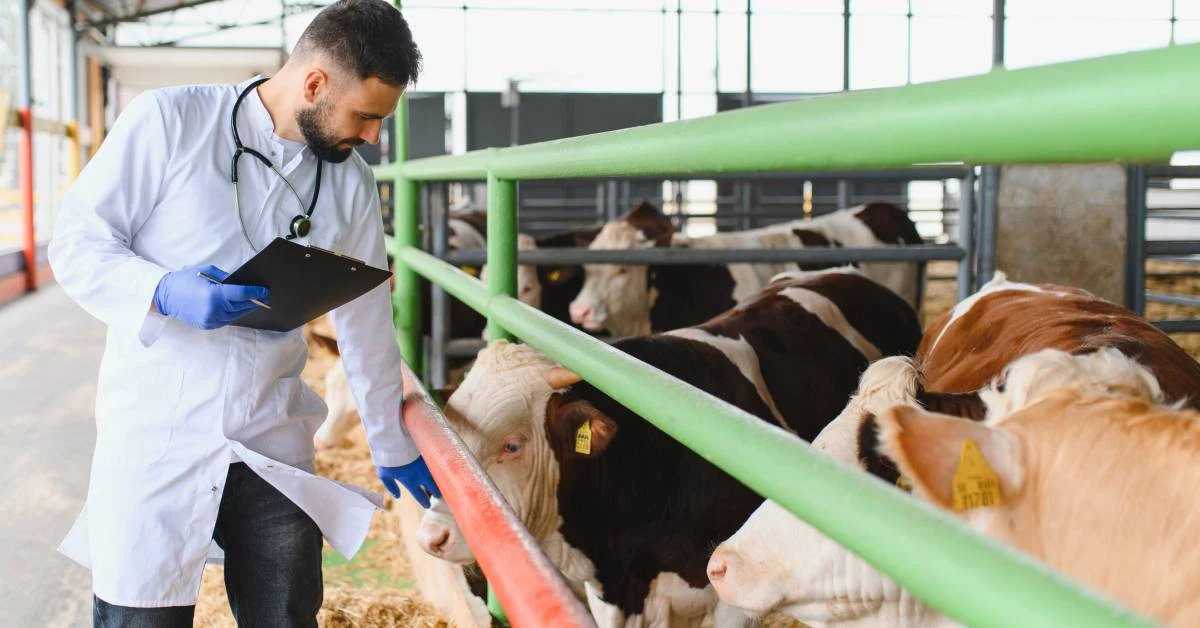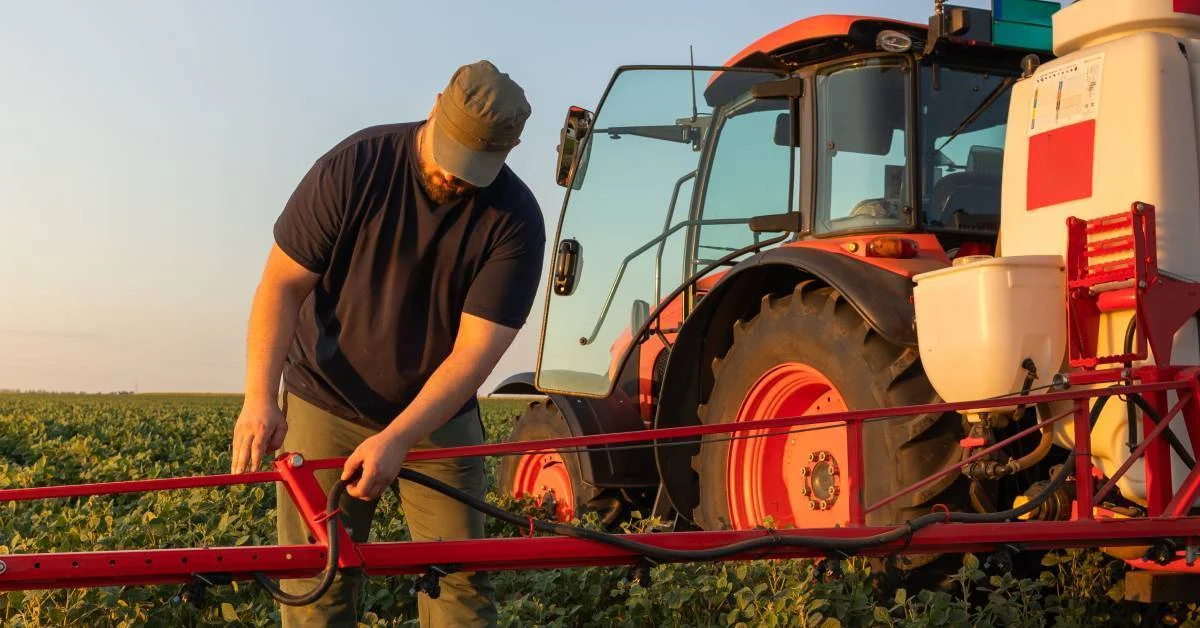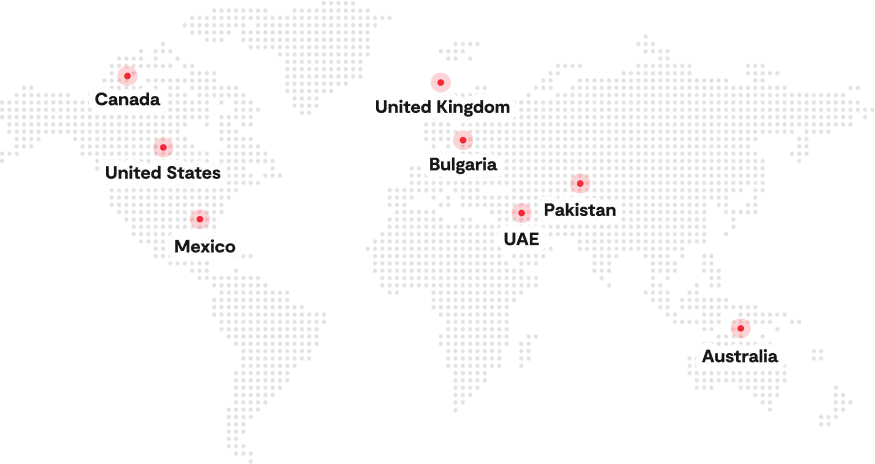Agriculture has faced mounting challenges in recent years, from labor shortages and rising costs to the need for more sustainable practices. In response, drones in farming have taken flight, quickly becoming a game-changer for farmers worldwide.
With projections showing the agricultural drone market reaching $4.8 billion by 2025, it’s clear that these crewless aerial vehicles (UAVs) are revolutionizing farming operations. Drones offer precision like never before, streamlining tasks such as drone crop monitoring, soil analysis, and livestock management. They provide farmers with a level of accuracy that manual labor simply can’t match.
In this article, we’ll explore how drones in farming save farmers time and money and ensure more sustainable practices. From improving crop health to enhancing livestock management, drones in farming are reshaping modern farming for a more productive future.
What are Agricultural Drones? – Overview of Agricultural Drone Models
Developing agricultural drone models represents a leap toward more efficient, sustainable farming as technology and agriculture continue to intersect. With drone technology evolving rapidly, the latest models are now equipped with advanced capabilities that empower farmers to gather real-time data, optimize resource use, and improve yields.
From extended battery life to AI-powered crop management software, these drones are changing the industry of modern agriculture. With drone farming, farmers are no longer limited to traditional crop monitoring using drones or irrigation management methods. Instead, they have cutting-edge tools that provide insights into everything from soil health to pest control, making drone use in agriculture an essential part of the future of farming.
Types of Drones in Farming- Fixed-Wing, Multirotor, and Hybrid Models
Agricultural drones come in various models, each designed for specific tasks. Among the most common types of drones in farming are fixed-wing, multirotor, and hybrid drones:
- Fixed-Wing Drones: These are ideal for large-scale farms due to their long-flight endurance and ability to cover expansive areas quickly. They are designed for efficiency, allowing for continuous data collection over vast plots.
- Multirotor Drones: These are better suited for smaller plots of land, offering speed and agility for focused tasks such as crop inspection or localized pesticide application.
- Hybrid Drones: Combining the best of both worlds, hybrid drones offer the endurance of fixed-wing models with the versatility of multi-rotors, making them suitable for a variety of farming operations.
Advanced Agricultural Drone Models – Key Features
Today’s drones in farming are built to meet the demanding needs of modern agriculture, equipped with a range of high-tech features that make them indispensable for farmers. Here are some of the most significant features that are transforming farming and drone use in agriculture:
1. Thermal and Multispectral Sensors – A New Dimension of Crop Monitoring
One of the most revolutionary aspects of drones in farming is their ability to capture data beyond what the human eye can see. Using multispectral and thermal imaging, these drones allow farmers to assess crop health and identify stress factors that would otherwise go unnoticed.
- Multispectral Sensors: These sensors collect data at various wavelengths, including infrared, providing insights into plant health, nutrient deficiencies, and stress levels. Analyzing multispectral data, farmers can make informed decisions on irrigation, fertilization, and pest control, contributing to healthier crops and increased yields.
- Thermal Sensors: These sensors are beneficial for detecting variations in ground temperature, which can indicate irrigation issues, pest activity, or structural problems in farm buildings. With drones in farming, farmers can address these concerns early with thermal data, preventing costly damage or crop loss.
2. High-Resolution Imaging – Detailed Insights for Smarter Farming
High-resolution cameras on drones offer farmers a bird’s-eye view of their fields, capturing images with exceptional clarity. Smart farming allows for precision in monitoring crops, identifying potential issues, and optimizing resource allocation.
These images not only enhance crop health monitoring but also aid in resource management by helping farmers understand soil conditions and water distribution, ultimately optimizing input use and improving efficiency. Some of the critical uses of high-resolution imaging with drones for agriculture include:
- Weed Detection: Drones in farming can identify weed growth in specific areas, enabling farmers to apply herbicides only where needed and reducing chemical use and costs.
- Crop Monitoring: High-resolution imagery allows farmers to closely track crop growth and identify issues like nutrient deficiencies, pest infestations, or diseases in the early stages.
- Soil Analysis: Drones help map out detailed soil compositions, moisture levels, and areas that may need attention, allowing for more precise resource management.
3. Autonomous Flight – Efficiency at the Push of a Button
One of the most significant advancements in agricultural drones is their autonomous flight capabilities. Drones for agriculture can now perform complex tasks without continuous human control, following pre-set flight paths to systematically survey large farming areas. This feature enables farmers to collect data efficiently, freeing them from the time-consuming task of manual monitoring.
With drones in farming, farmers can program flight routes and waypoints, allowing drones to cover extensive fields with minimal oversight. This autonomy is particularly useful for large-scale farms, where manual surveillance would otherwise be impractical.
4. GPS Precision – Accurate Field Mapping for Better Decision-Making
Equipped with GPS systems, agricultural drones can precisely navigate and map fields down to the smallest detail. This geolocation data allows farmers to create accurate field maps, which they can use to monitor crop health, soil conditions, and irrigation needs with greater precision.
Drones in farming use GPS data, and drones can also return to the same points for follow-up inspections, ensuring consistent data collection over time. This repeatability is invaluable for tracking changes in crop health or soil composition, helping farmers make more informed decisions and improving the overall efficiency of farm management.
The Role of Drones in Precision Agriculture

Precision agriculture has always aimed to optimize resource use while increasing yields, and drones are at the forefront of this movement. Drones agriculture helps in capturing real-time data from the sky, and drones help farmers make better, data-driven decisions.
Drones agriculture provides an essential solution to rising operational costs and increasing pressure to implement sustainable practices. Their ability to gather precise data on crops, soil, and livestock allows farmers to operate more efficiently, reducing waste and maximizing output.
So, in an era where sustainability is not just a goal but a necessity, drones for agriculture remain both productive and environmentally conscious. Farmers who use drone technology are setting themselves up for long-term success, gaining a competitive edge in a rapidly evolving industry.
How Drones Improve Crop Health Monitoring and Yield?
One of the most significant benefits of drones in farming is their ability to accurately monitor crop health. Equipped with advanced sensors and imaging capabilities, drones can detect variations in crop conditions that the human eye might miss.
For example, drones for agriculture can reveal plant health through multispectral imaging in ways that standard field checks cannot. Studies show that using drone crop monitoring can increase yields by up to 15%. Some farmers have reported reducing pesticide use by 30% by identifying problem areas early. Drone-assisted irrigation systems have also contributed to a 20% reduction in water usage, making farming more sustainable.
How Does Drone Technology Help With Efficient Livestock Management?
Drones in farming isnt just for crops. They’re also essential in managing livestock. Monitoring large herds, particularly in remote areas, can be labor-intensive and time-consuming.
Drones for farming are equipped with thermal imaging that can track livestock movements, identify sick animals, and even assist in herd counting. This aerial surveillance saves farmers countless hours and ensures that livestock is managed efficiently, even in difficult-to-reach areas.
How Do Agricultural Drones Help Improve Irrigation and Resource Management?
Water conservation is a pressing issue in modern agriculture, and drones provide solutions. UAVs can scan large areas to detect variations in moisture levels, allowing farmers to tailor irrigation efforts precisely where needed. This precision reduces water waste and improves crop health.
A study conducted in California demonstrated a 25% increase in water efficiency after drones were integrated into irrigation systems. The ability to assess soil health and manage water resources from the sky is turning drones into vital tools for sustainable farming practices.
The Benefits of Drone Technology for Farmers
Farming drones are transforming how farmers manage their crops and resources, becoming an essential tool in precision agriculture. This approach uses technology to ensure crops and soil receive the exact care they need for optimal health and yield. Here’s how drones in farming are revolutionizing this modern farming practice:
1. Enhanced Crop Monitoring
One of the most significant benefits of drones in agriculture is their ability to perform detailed crop monitoring. Traditional methods of checking crop health and growth, which rely on manual labor, can be time-consuming and imprecise.
By providing aerial views that can’t be achieved from the ground, drones offer farmers a comprehensive understanding of their crops’ conditions. This data allows for timely interventions, reducing the likelihood of large-scale crop damage. Farming drones, however, can cover large fields quickly, taking high-resolution images that will enable farmers to:
- Detect early signs of disease, nutrient deficiencies, or pest infestations.
- Monitor plant growth stages in real-time.
- Identify areas needing irrigation or fertilizer.
2. Precision in Resource Management
Resource optimization is a cornerstone of precision agriculture, and drones play a pivotal role here. Equipped with sensors and GPS technology, drones provide farmers with detailed maps and data on soil composition, moisture levels, and crop health.
For example, drones in farming can identify a specific area that requires more fertilizer, allowing the farmer to precisely fertilize the area rather than blanket spraying the entire field. This saves resources and minimizes environmental impact. This information enables farmers to:
- Apply water, fertilizers, or pesticides only where needed, reducing waste and lowering costs.
- Use multispectral or thermal sensors to detect water stress, helping optimize irrigation efforts.
- Spot areas of underperforming crops and adjust inputs accordingly to boost yields.
3. Improved Field Mapping and Planning
Drones in farming provide accurate field mapping, which is crucial for farm planning. Using geospatial data and advanced imaging techniques, drones can create 3D maps of fields, revealing topographical details like slopes, drainage patterns, and elevation changes.
Generating precise maps leads to better decision-making and improved farm management, especially in large-scale operations. These maps help farmers:
- Design efficient irrigation systems.
- Plan planting and harvesting schedules.
- Identify zones prone to flooding or poor drainage, reducing crop loss.
4. Real-Time Data Collection and Analysis
The real-time data drones provide is invaluable for making quick and informed decisions in the field. Instead of waiting for manual inspections or satellite imagery, farmers can deploy drones to capture live data on their crops’ conditions. This enables rapid responses to emerging problems such as pest outbreaks, ensuring minimal damage to crops.
Furthermore, many drones are integrated with AI-powered software that instantly processes and analyzes agriculture data, giving farmers actionable insights. For example, drones in farming can detect pest infestations early, allowing for targeted pesticide application that prevents a full-blown outbreak.
5. Precision in Planting and Seeding
Drones in farming also help to improve planting techniques. With drone-seeding technology, drones can rapidly distribute seeds over large areas. Drone seeding ensures uniform distribution, optimizing plant growth and reducing the need for human labor. In some cases, drones have been shown to plant seeds up to 10 times faster than traditional methods.
This is particularly useful for:
- Reforestation projects.
- Cover crops in large fields.
- Areas were difficult to reach with conventional equipment.
6. Increased Sustainability and Efficiency
The ability to apply resources with precision not only increases efficiency but also enhances sustainability. With drones in farming, you can monitor crops and apply inputs where they are truly needed. Farmers can reduce their overall use of water, pesticides, and fertilizers. This minimizes the environmental impact of farming while ensuring that crops receive the necessary care.
For instance, drones in farming are equipped with sprayers that can apply pesticides or fertilizers more targeted and even than traditional machinery. This precision spraying reduces chemical runoff into surrounding ecosystems and prevents the over-application of harmful substances.
What Are the Key Challenges in Implementing Drones on Farms?
The key challenges in implementing drones in farming include:
- Regulatory Compliance: Farmers must navigate complex drone regulations, including obtaining permits, meeting flight restrictions, and adhering to privacy laws, which vary by region.
- High Upfront Costs: The initial investment in drone equipment, along with training for operation and maintenance, can be expensive, especially for smaller farms.
- Data Processing and Analysis: Drones generate vast amounts of data, requiring specialized software and expertise to process and analyze, which may be a barrier for farmers unfamiliar with advanced agriculture technologies.
Considerations for Implementing Drones
Key considerations for implementing drones in farming include:
- Purpose and Use: Identify specific needs, such as crop monitoring, irrigation management, or pest control, to select the right drone and features.
- Budget: Account for initial costs (drone procurement, sensors) and ongoing expenses (maintenance, software, training).
- Regulatory Compliance: Ensure adherence to local drone laws, including permits, flight restrictions, and safety guidelines.
- Training and Expertise: Operators need proper training to use drones effectively and interpret the data they collect.
- Data Management: Invest in software and analytics tools to process drone-captured data for actionable insights.
Ready to Upgrade Your Farming with Drones Technology?
Drones have rapidly become indispensable tools for modern farmers. They are revolutionizing the industry by offering precise, real-time data that enhances efficiency, reduces costs, and promotes sustainability. Farming with drones becomes more than just a labor-intensive process. It evolves into a data-driven, highly efficient, and environmentally responsible industry.
Consider integrating drone technology today if you’re ready to transform your farming operations. Contact us to learn more about how drones in farming can optimize your agricultural processes, boost yields, and help you achieve more sustainable farming practices.
FAQs
What is an Agricultural Drone?
An agricultural drone is an unmanned aerial vehicle (UAV) designed to support farming operations by capturing real-time data on crop health, soil conditions, and livestock management. These drones for farming help farmers optimize yield, monitor crop growth, detect issues leading to more precise and sustainable farming practices.
What are the Benefits of Using Drones in Farming?
Drones in farming, including improved crop monitoring, precision in resource management, real-time data collection, and enhanced field mapping. They help farmers detect issues like pests, nutrient deficiencies, or irrigation problems early, reducing crop loss and increasing yields.
How are Drones Changing the Future of Agriculture?
Drones in farming is transforming agriculture by providing real-time data and enabling precision farming. They help monitor crop health, optimize irrigation, and detect pests early, leading to increased productivity and sustainability. As technology advances, drones will further enhance farm management and decision-making, driving efficiency and higher yields.







